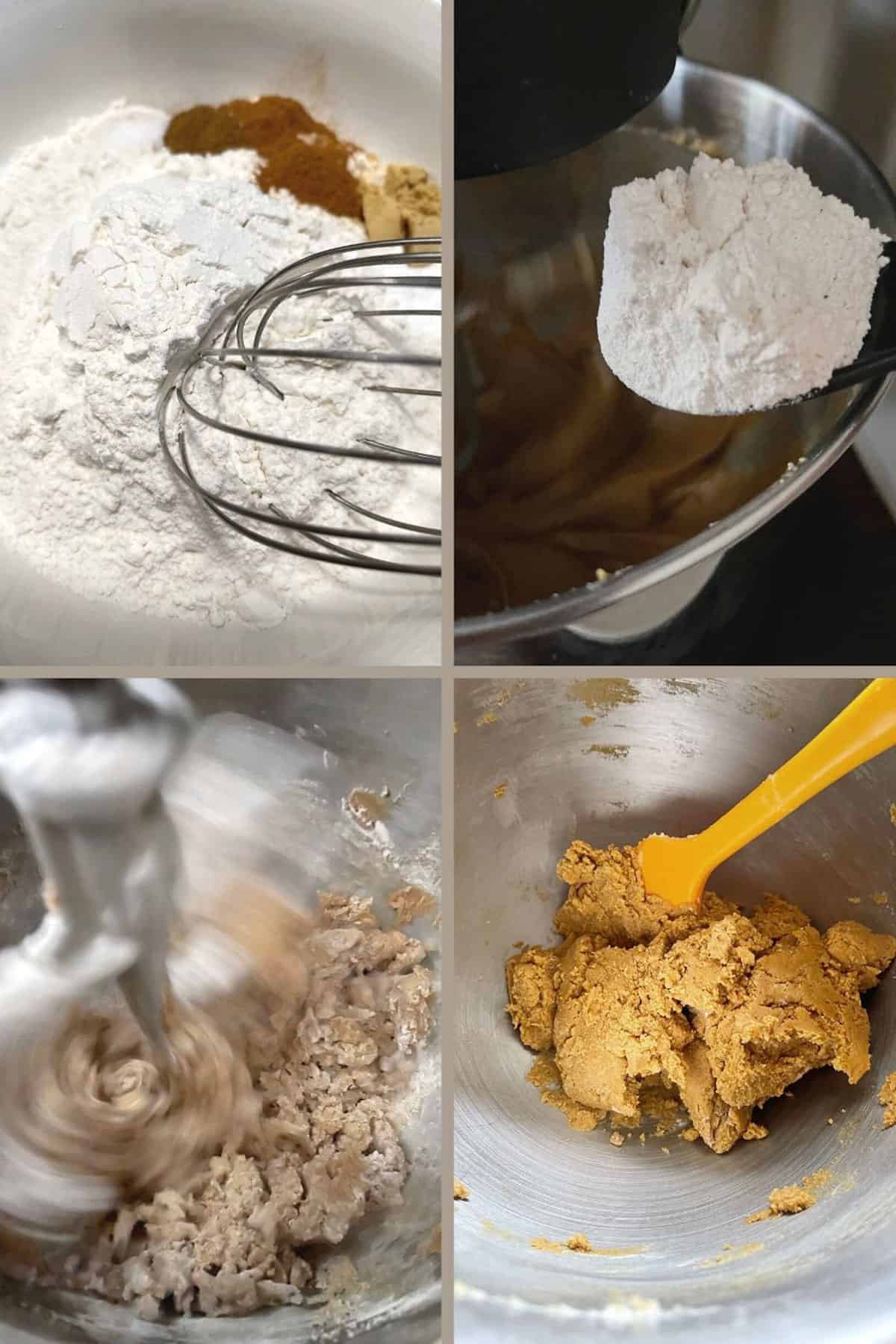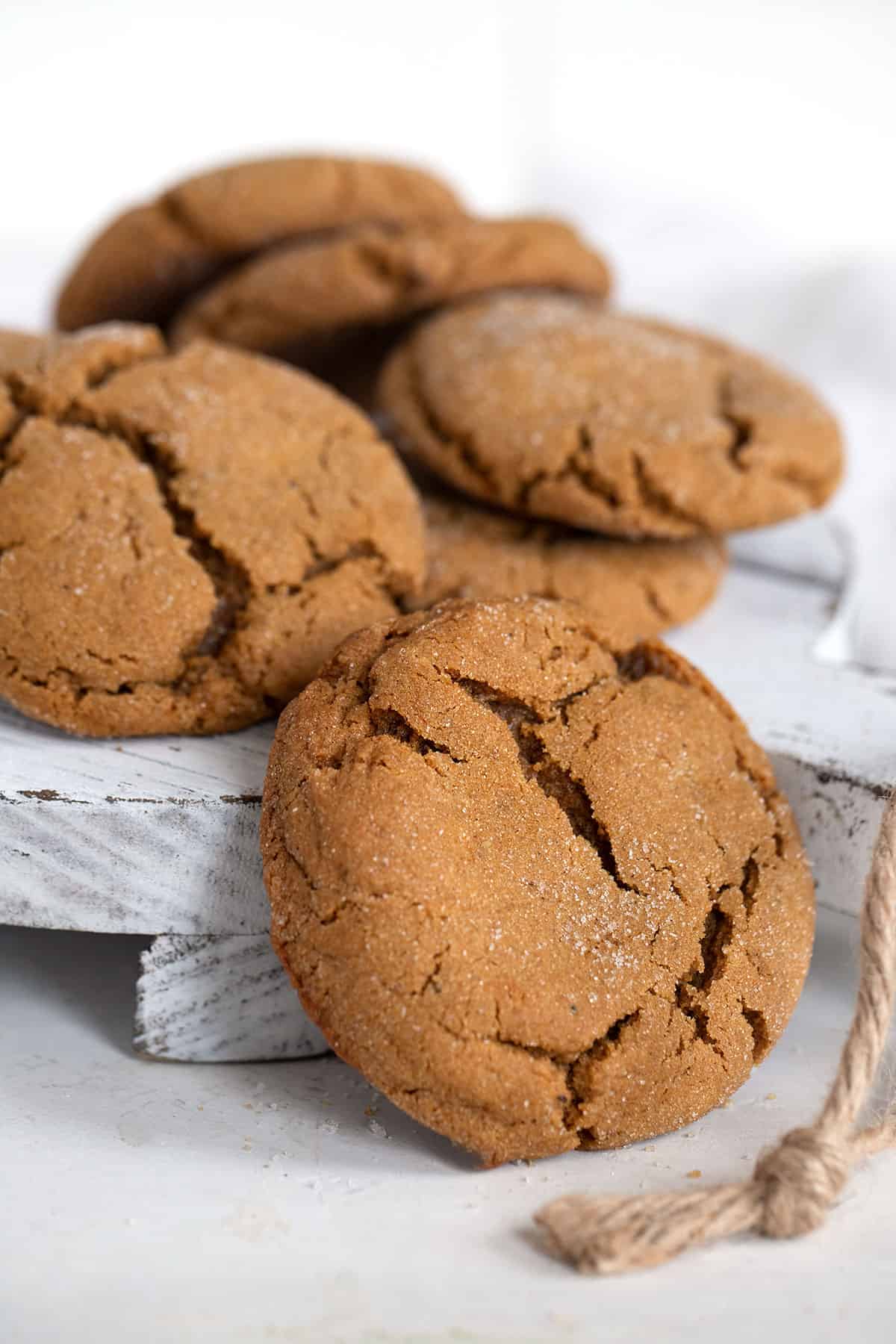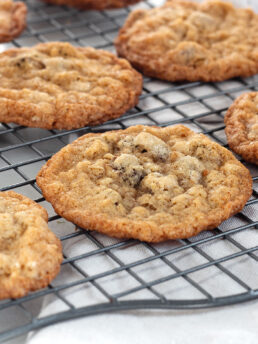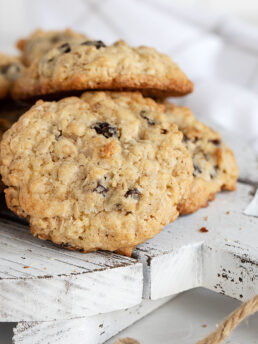These big and soft old-fashioned molasses cookies are both delicious and easy. These cookies bake up nice and thick, are wonderfully soft and chewy and with just the right amount of warm spices.

If you are looking for a molasses cookies recipe like grandma made, look no further than these old fashioned molasses cookies! This vintage recipe produces thick, soft and chewy cookies, with all the wonderfully warming spices you want from a molasses cookie.
The combination of shortening and butter in this cookie dough is a “best of both worlds” combination. The shortening helps the cookies to bake up taller and more tender, while the butter provides the cookies with more flavour, that is often lacking in shortening-only cookies. The result is a soft cookie with a great chewy texture.
Ingredients and substitutions
A few notes about the key ingredients …
Molasses – I recommend a light molasses for these cookies, commonly known as “Fancy” molasses.. It’s what I always use. A dark molasses such as “Cooking” molasses may work here and provide a stronger molasses flavour, if that’s your preference, though I haven’t tested this specific recipe with cooking molasses. Blackstrap molasses is not recommended as it is simply too strong in flavour for cookies.
Shortening and Butter – as noted above, using a combination of both solid vegetable shortening and softened butter, provides the benefit of both of these ingredients in baking. I highly recommend using this combination! That said, you can use all shortening or all butter in the same quantities, if you like. The texture/height of the cookies will change somewhat with this substitution, though it won’t affect the deliciousness.
Butter – you can use either salted or unsalted butter for these cookies. The recipe specifies salted butter, but unsalted works fine. Simply add a pinch more salt if using unsalted.
Spices – Of all the spices, cloves is often the most contentious. Some like a lot, some like a little. Feel free to adjust the amount in these cookies up or down 1/4 tsp, to your taste. I’m not generally a clove lover, but I find the amount as written just right.

Step 1: Place the room temperature butter, shortening and white sugar in bowl.
Step 2: Cream the mixture on medium speed until light and fluffy (about speed 4 or 5 on a Kitchenaid mixer for about 2 minutes).
Step 3: Add the molasses and egg.
Step 4: Beat mixture until smooth.

Step 5: Combine the flour, baking soda and spices in a bowl and whisk together well.
Step 6: With the mixer on low, spoon in the flour mixture.
Step 7: Mix on low speed to incorporate the flour, until the mixture comes together as a moist dough with no visible flour.
Step 8: Mix until the mixture comes together as a moist dough with no visible flour.

Step 9: Transfer the dough to a bowl, cover with plastic wrap and refrigerate at least 1 hour or up to 24 hours.
Step 10: Using a cookie scoop or a tablespoon measure, scoop off a piece of dough and roll into a ball about 1 1/2-inches in diameter (test the first one, then make the rest of them the same size).
Step 11: Roll the balls in white granulated sugar.
Step 12: Place cookies onto an un-greased baking sheet spaced about 3 inches apart and bake for 13-15 minutes.
Recipe tips!
- Be sure to keep your cookies the same size, so they will bake evenly. You can use a scale if you like.
- The baking time is for the size of cookies as specified (1 1/2-inches diameter). If you make smaller cookies, you’ll want to adjust the baking time down accordingly.
- Oven and baking pans vary from kitchen to kitchen, so the baking time in your oven may vary a minute or so one way or the other. To be sure you get perfect cookies, consider baking a “test cookie” for the recommended time, allow to cool and taste. The cookie should be soft (not crispy) and the inside of the cookie should be set and light. Adjust baking time for the rest of the cookies up or down slightly, as needed.
- You’ll want to remove the cookies from the baking sheet quite quickly after removing them from the oven (to prevent further cooking). That said, they are quite soft, so transfer carefully.
Storage and freezing
These cookies will keep well in an air-tight container at room temperature for 7-10 days.
You can definitely freeze these cookies, as well. Simply transfer to a freezer container after they are completely cool and freeze up to 2 months.
How to measure vegetable shortening
You can spoon the shortening into a tablespoon measure and level it with a knife (a 1/4 cup equals 4 level tablespoons). You can also slice from a block with the measures on the edge of the box. That said, there is a super easy and less messy way to measure shortening! It’s called the water displacement method.
Simply fill a liquid measuring cup with water to the 1/4 cup level. Add drops of shortening to the water, until the water level rises to the 1/2 cup level. That’s 1/4 cup of shortening! Spoon the shortening out and shake off any excess water, then add it to the bowl.

- If the cookies spread more than expected and are thin and crispy (instead of thicker and chewy), your dough needs more flour.
- If the cookies don’t flatten out enough from the ball shape you started with, your dough has too much flour.
- If your cookies are wet inside, they need to cook longer.
- If your cookies are crisp, they need to cook less.
Want to save this recipe?
Enter your email and I’ll send it to your inbox. Plus, you’ll get great new recipes from me every week!
By submitting this form, you consent to receive emails from Seasons and Suppers.
You can unsubscribe at any time.

Ingredients
- 1/4 cup (57 g) butter, salted or unsalted, at room temperature
- 1/4 cup (48 g) vegetable shortening, *see Note 1 below
- 3/4 cup (138 g) white granulated sugar
- 1/4 cup (55 ml) light, un-sulphured "Fancy" molasses
- 1 large egg, lightly beaten
- 2 1/4 cups (286 g) all-purpose flour, spooned and levelled
- 1 1/8 teaspoon baking soda
- 1 1/8 teaspoon ground ginger
- 3/4 teaspoon ground cinnamon
- 1/2 teaspoon ground cloves
- 1/4 teaspoon salt, add a pinch more is using unsalted butter
To roll cookies before baking:
- white granulated sugar, for coating cookies (about 1/4 cup)
Instructions
- Tip! If you have a kitchen scale, I highly recommend using the weight measurements provided for the best, most consistent results. If you don't have a scale, be sure to measure the flour with the spoon and level method.
- In a medium bowl, whisk together the flour, baking soda, ginger, cinnamon, cloves and salt. Set aside.
- In a large bowl with an electric mixer or the bowl of a stand mixer fitted with the paddle attachment, cream together the shortening, softened butter and sugar until light and fluffy, about 2 minutes at medium speed. Add the egg and molasses and beat in until smooth and creamy.
- Add the flour mixture and mix on low until the mixture comes together as a moist dough. Remove dough to a bowl, cover with plastic wrap and chill in the refrigerator for at least 1 hour or up to 24 hours.
- Preheat oven to 350F (non-convection/not fan-assisted).
- Using a cookie scoop or a tablespoon measure, take a scoop of the dough and form into a 1 1/2-inch diameter ball (check the size of the first one and then make the remaining ones the same size). Roll the ball in white granulated sugar and place onto an un-greased baking or cookie sheet about 3 inches apart. Repeat forming balls and rolling in sugar until your baking sheet is full. Cover and refrigerate any remaining dough to make another batch later.
- Bake in preheat oven for about 14-15 minutes. Cookies will look puffy, but will deflate as they cool. Remove from oven, let stand about 1 minute, then carefully transfer to a wire rack to cool completely. Cookies should not have spread much, should be thick, and the inside should be dry and set. If the centre of the cookie is moist, adjust the baking time, adding more time as necessary.
Notes
Hi! I’m Jennifer, a home cook schooled by trial and error and almost 40 years of getting dinner on the table! I love to share my favourite recipes, both old and new, together with lots of tips and tricks to hopefully help make your home cooking enjoyable, stress free, rewarding and of course, delicious!







Can I replace the molasses with brown sugar
HI Pina and I don’t really think so. It wouldn’t be an even swap for sure, and since molasses is a liquid and brown sugar isn’t, it may affect the dough moistness and over-all sweetness of the cookie. I would suggest honey as a one-for-one substitute, but that said, you might be better off finding another sugar cookie recipe to try, rather than making a molasses cookie without molasses.